NASA’s new NEO Surveyor spacecraft will search for the hardest-to-find asteroids and comets that could pose a threat to our planet, making it the agency’s first space telescope designed specifically for planetary defense. The impact craters that scar the Earth’s surface are evidence of the enormous impact asteroids have had on the history and development of our planet.
NASA’s new asteroid-hunting spacecraft is taking shape at NASA’s Jet Propulsion Laboratory in Southern California. Called the Near-Earth Object Surveyor (NEO Surveyor), the advanced infrared space telescope will search for the hardest-to-find asteroids and comets that could pose a threat to our planet. In fact, it’s the agency’s first space telescope designed specifically for planetary defense.
Scheduled to launch in late 2027, the spacecraft will fly a million miles to a region of gravitational stability — called the L1 Lagrange point — between Earth and the sun. From there, its large sunshield will block the glare and heat of sunlight, allowing the mission to detect and track near-Earth objects approaching Earth from the sun, something that other observatories have struggled to do. The space telescope could also detect asteroids called terrestrial Trojans that lead and trail our planet’s orbit and are difficult to see from Earth or Earth orbit.
NEO Surveyor uses state-of-the-art detectors that look for two bands of infrared light that are invisible to the human eye. Near-Earth objects, no matter how dark they are, glow brightly in the infrared because the Sun heats them. This will allow the telescope to find dark asteroids and comets that don’t reflect much visible light. It will also measure these objects, a challenge for visible-light telescopes, which have trouble distinguishing between small, highly reflective objects and large, dark ones.
“NEO Surveyor is optimized to help us do one specific thing: enable humanity to find the most dangerous asteroids and comets early enough that we can do something about them,” said Amy Mainzer, director of research for NEO Surveyor and a professor at the University of California, Los Angeles. “We aim to build a spacecraft that can find, track, and characterize the objects with the highest chance of impacting Earth. In the process, we’ll learn a lot about their origins and evolution.”
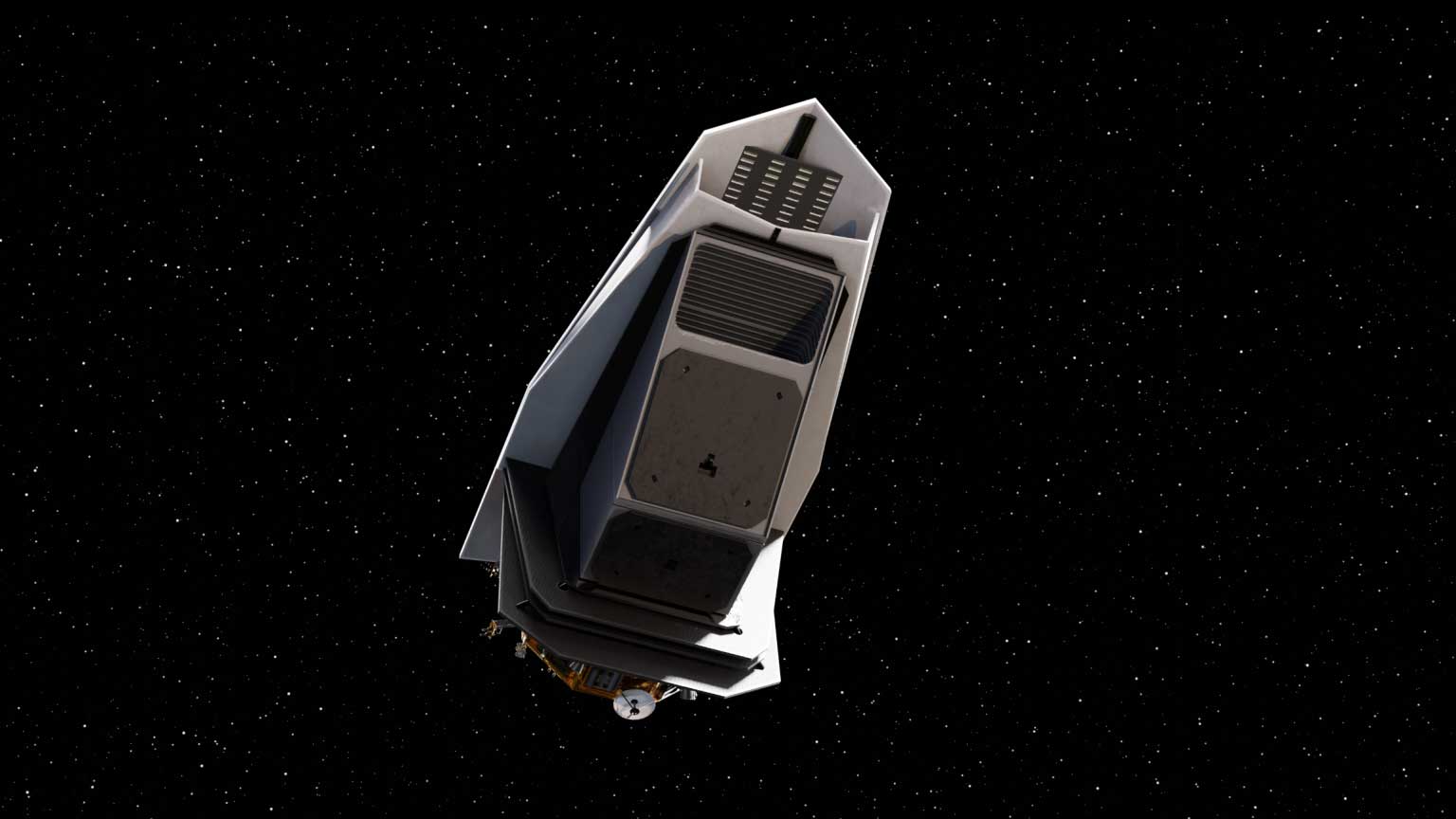
This artist’s concept depicts NASA’s NEO Surveyor in deep space. The black paneled, angular structure on the bottom of the spacecraft is an instrument housing being built at JPL. The mission’s infrared telescope will be mounted inside the housing. NASA/JPL-Caltech
The spacecraft’s only instrument is a telescope. About the size of a washer and dryer set, the telescope’s massive aluminum body, called the optical bench, was built in a clean room at JPL. Known as a three-mirror anastigmatic telescope, it will rely on curved mirrors to focus light onto its infrared detectors in a way that minimizes optical aberrations.
“We carefully managed the fabrication of the spacecraft’s telescope mirrors, all of which were delivered to JPL’s cleanroom by July,” said Brian Monacelli, JPL’s chief optical engineer. “The mirrors were formed and polished from solid aluminum using a diamond lathe. Each one exceeded mission performance requirements.”
Monacelli inspected the mirror surfaces for debris and damage, then a team of JPL optical-mechanical technicians and engineers attached the mirrors to the telescope’s optical bench in August. They will then measure the telescope’s performance and align its mirrors.
Complementing the mirror assembly are the telescope’s mercury, cadmium, and telluride detectors, which are similar to those used by NASA’s recently canceled NEOWISE (short for Near-Earth Object Wide-field Infrared Survey Explorer) mission. The advantage of these detectors is that they don’t necessarily require cryogenic coolers or cryogens to lower operating temperatures to detect infrared wavelengths. Cryogens and cryogens can limit the life of a spacecraft. Instead, NEO Surveyor will stay cool by using its large sunshield to block sunlight from heating the telescope and by occupying an orbit beyond the Moon’s orbit, minimizing heating from Earth.
The telescope will eventually be mounted inside the spacecraft’s instrument housing, which is being assembled in JPL’s historic High Bay 1 cleanroom, where NASA missions like Voyager, Cassini, and Perseverance were built. The housing, made of a dark composite material that allows heat to escape, will help keep the telescope cool and prevent its own heat from interfering with observations.
Once completed, the enclosure will be tested in the coming weeks to ensure it can withstand the rigors of space exploration. It will then be installed on the back of the sunshield and on top of the electronic systems that will power and control the spacecraft.
“The entire team has worked long and hard to get to this point, and we’re excited to see the hardware come together with contributions from our institutional and industrial partners from across the country,” said Tom Hoffman, NEO Surveyor project manager at JPL. “From panels and cables for the instrument body to detectors and mirrors for the telescope — and components to assemble the spacecraft — the hardware is being manufactured, delivered, and assembled to build this incredible observatory.”
The NEO Surveyor mission marks a major step toward NASA’s goal set by Congress to detect and characterize at least 90 percent of near-Earth objects larger than 460 feet (140 meters) across that are within 30 million miles (48 million kilometers) of our planet’s orbit. Objects that size could cause significant regional damage or worse if they collided with Earth.
The mission is assigned to NASA’s Planetary Science Division within the Science Mission Directorate; the program is overseen by the Planetary Defense Coordination Office, which was created in 2016 to manage the agency’s ongoing planetary defense efforts. NASA’s Planetary Mission Program Office at the agency’s Marshall Space Flight Center provides program management for NEO Surveyor.
The project is being developed by JPL and led by survey director Amy Mainzer of the University of California, Los Angeles. Well-known aerospace and engineering companies have been awarded contracts to build the spacecraft and its instruments, including BAE Systems, Space Dynamics Laboratory, and Teledyne. The Atmospheric and Space Physics Laboratory at the University of Colorado, Boulder, will support operations, and IPAC-Caltech in Pasadena, California, is responsible for processing the survey data and creating mission data products. Caltech manages JPL for NASA.
China has called for speeding up the development of weapons to protect Earth from asteroids. Scientists from the Beijing Institute of Spacecraft Design have called for the development of nuclear weapons to protect against asteroids, writes the South China Morning Post.
“The researchers said their analysis showed that in some situations only nuclear weapons could prevent an asteroid from hitting Earth, adding that they were fully aware of international laws prohibiting the use or deployment of nuclear weapons in space and that nuclear fallout could also cause contamination of interstellar space,” the publication said.
At the same time, they called on decision makers to think long-term and support research and development in nuclear defense to prevent the doomsday threat to humanity.
As scientists emphasize, the real risk of our planet colliding with a large asteroid is much higher than previous estimates. In their opinion, to prevent such threats, it is necessary to have the ability to launch nuclear warheads into space within a very short period of time, which can be from seven to thirty days.
For the benefit of all, NASA has released a summary of the fifth biennial interagency planetary defense exercise. NASA’s Planetary Defense Coordination Office, in partnership with FEMA and with assistance from the U.S. Department of State’s Office of Space Affairs, organized the tabletop exercise to inform and assess the ability to effectively respond to the threat of a potentially hazardous asteroid or comet.
While there are no known significant asteroid impact threats in the foreseeable future, hypothetical exercises provide valuable insights by exploring the risks, response options, and opportunities for cooperation that arise in scenarios ranging from minor regional damage with little warning to potential global catastrophes projected years or even decades in the future.
“The uncertainty of these initial conditions for the exercise allowed participants to consider a particularly challenging set of circumstances,” said Lindley Johnson, planetary defense officer emeritus at NASA Headquarters in Washington. “A major asteroid strike is potentially the only natural disaster that humanity can predict years in advance and take action to prevent.”
During the exercise, participants considered potential national and global responses to a hypothetical scenario in which a never-before-seen asteroid was identified that, according to initial calculations, had a 72% chance of impacting Earth in about 14 years. However, the preliminary observations described in the exercise were insufficient to accurately determine the asteroid’s size, composition, and long-term trajectory. To complicate this year’s hypothetical scenario, significant follow-up observations would have to be delayed by at least seven months—a critical time penalty—because the asteroid would pass behind the Sun as seen from Earth’s perspective in space.
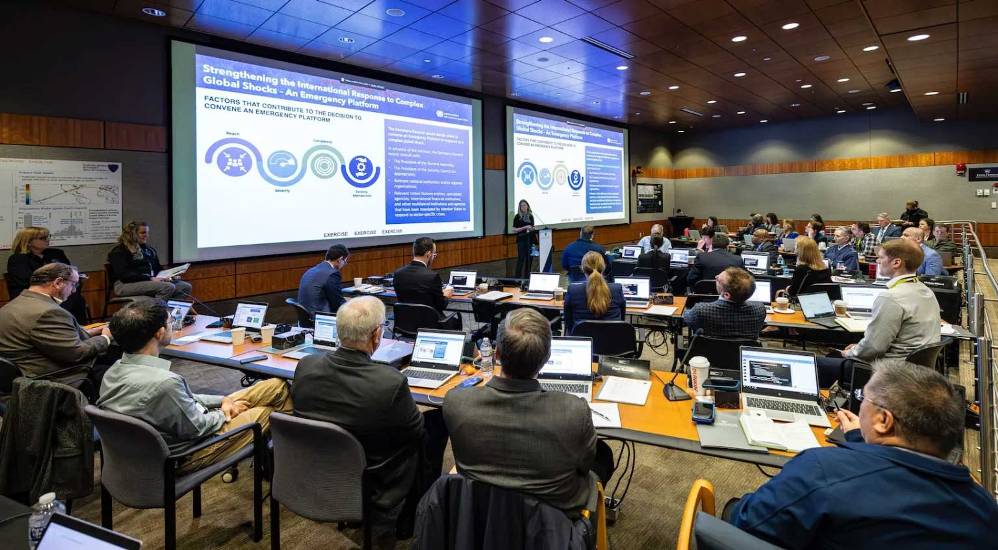
Representatives from NASA, FEMA, and the planetary defense community participate in the 5th Interagency Planetary Defense Command Post Exercise to inform and assess our ability as a nation to effectively respond to the threat of a potentially hazardous asteroid or comet. NASA/JHU-APL/Ed Whitman
The exercise allows government stakeholders to identify and address potential problems in preparation for any real-world situation. It was held in April at the Johns Hopkins Applied Physics Laboratory (APL) in Laurel, Maryland, and brought together nearly 100 representatives from across the U.S. government and, for the first time, international planetary defense colleagues.
The exercise was the first to use data from NASA’s Double Asteroid Redirection Test (DART) mission, the first space-based demonstration of technology to protect Earth from potential asteroid impacts. The DART spacecraft, which collided with the asteroid Dimorphos on September 26, 2022, confirmed that a kinetic impactor can change the asteroid’s trajectory. Applying this or any other technology to a real impact threat would require years of advance planning.
To help humanity have the time it needs to assess and respond to a potentially hazardous asteroid or comet, NASA is continuing development of its Near-Earth Object Surveyor (NEO), an infrared space telescope specifically designed to accelerate our ability to detect and characterize the most potentially hazardous near-Earth objects years before they become a collision threat. The agency’s proposed launch date for NEO Surveyor is set for June 2028.
The fifth interagency planetary defense command post exercise focused on an asteroid impact scenario developed by NASA’s Jet Propulsion Laboratory’s Center for Near Earth Object Studies.
A large asteroid impact with Earth is unlikely in the foreseeable future. But because the damage from such an event could be enormous, NASA conducts hypothetical asteroid impact exercises every two years with experts and decision makers from federal and international agencies to address the many uncertainties of an impact scenario. The most recent exercise took place in April of this year, and a preliminary report was released on June 20.
Making such a scenario realistic and useful for all involved is no easy task. Scientists at the Center for Near-Earth Object Studies (CNEOS) at NASA’s Jet Propulsion Laboratory in Southern California, which specializes in tracking and determining the orbits of asteroids and comets and identifying hazards to Earth, have played a major role in developing the exercise since its inception 11 years ago.
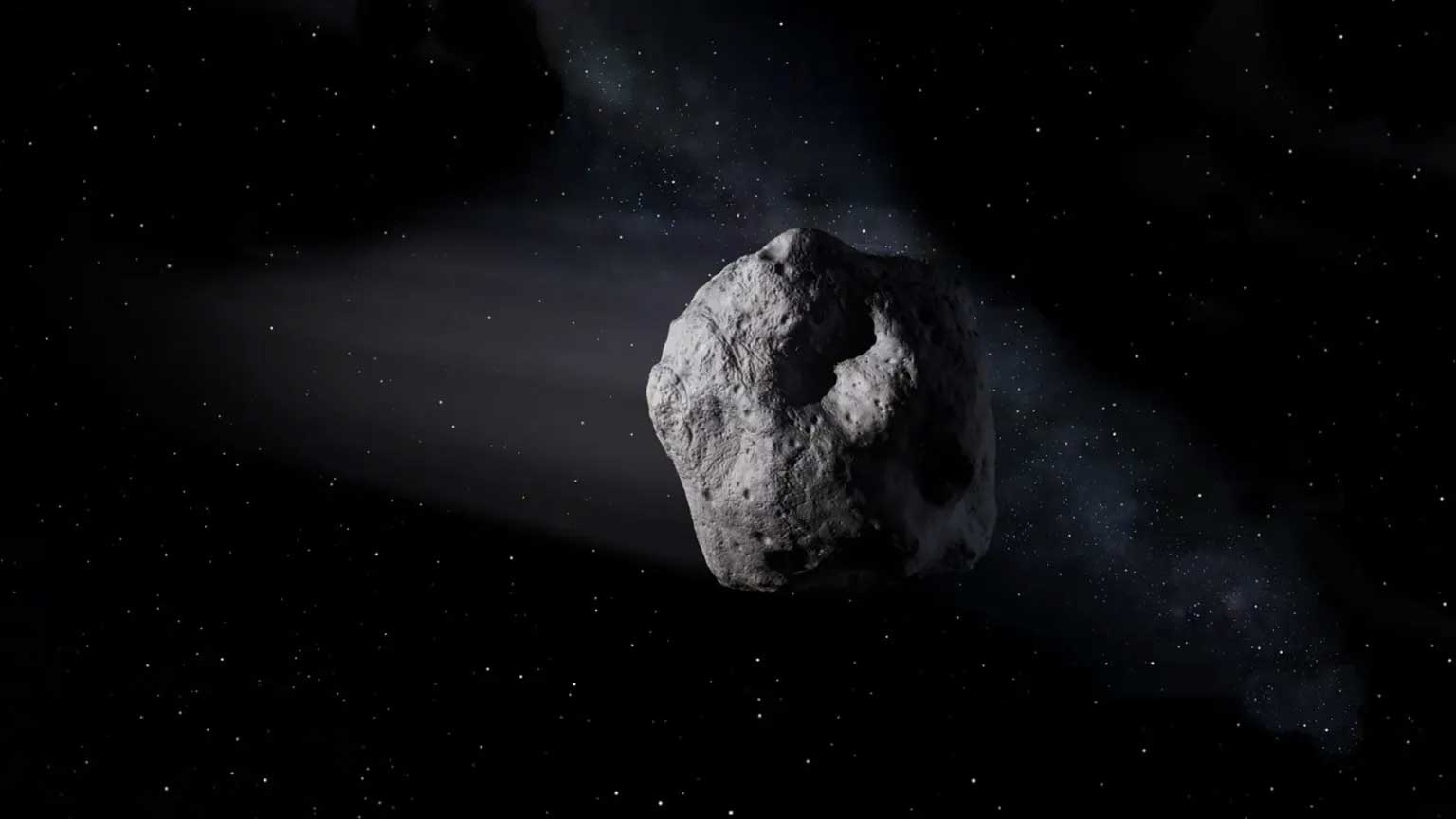
This artist’s concept depicts an asteroid drifting through space. Many such objects frequently fly past Earth. To help prepare for the discovery of an asteroid that could hit our planet, NASA conducts regular exercises to see how the international community might respond to such a threat. NASA/JPL-Caltech
“These hypothetical scenarios are complex and require significant effort to develop, so our goal is to make them useful and challenging for exercise participants and decision makers so they can hone their processes and procedures to quickly develop a plan of action while addressing gaps in the planetary defense community’s knowledge,” said JPL’s Paul Chodas, director of CNEOS.
This year’s scenario: A hypothetical asteroid, perhaps a few hundred yards across, is discovered with a 72% chance of hitting Earth within 14 years. Possible impact sites include heavily populated areas of North America, southern Europe, and northern Africa, but there is still a 28% chance the asteroid will not hit Earth. After months of tracking, the asteroid approaches too close to the Sun, making further observations impossible for the next seven months. Decision makers must decide what to do.
In real life, CNEOS calculates the orbit of every known near-Earth object to provide estimates of future potential impact hazards in support of NASA’s planetary defense program. To make this scenario realistic, the CNEOS team modeled all observations in the months leading up to the exercise and used orbit determination calculations to model the likelihood of impact.
The Deep Space Network’s Goldstone planetary radar has been busy for several days monitoring asteroids 2024 MK and 2011 UL21 as they safely flew past Earth.
Scientists at NASA’s Jet Propulsion Laboratory in Southern California recently tracked two asteroids flying past our planet. One was found to have a small moon, and the other was discovered just 13 days before its closest approach to Earth. There was no risk that either near-Earth object would collide with our planet, but radar observations made during these two close encounters will provide valuable practice for planetary defense, as well as information about their sizes, orbits, rotations, surface features, and clues about their composition and formation.
Flying past Earth on June 27 at a distance of 4.1 million miles (6.6 million kilometers), or about 17 times the distance between the moon and Earth, asteroid 2011 UL21 was discovered in 2011 by the NASA-funded Catalina Sky Survey in Tucson, Arizona. But this is the first time it has come close enough to Earth to be seen by radar. Although the nearly mile-wide (1.5 kilometers) object is classified as potentially hazardous, calculations of its future orbits suggest it will not pose a threat to our planet anytime soon.
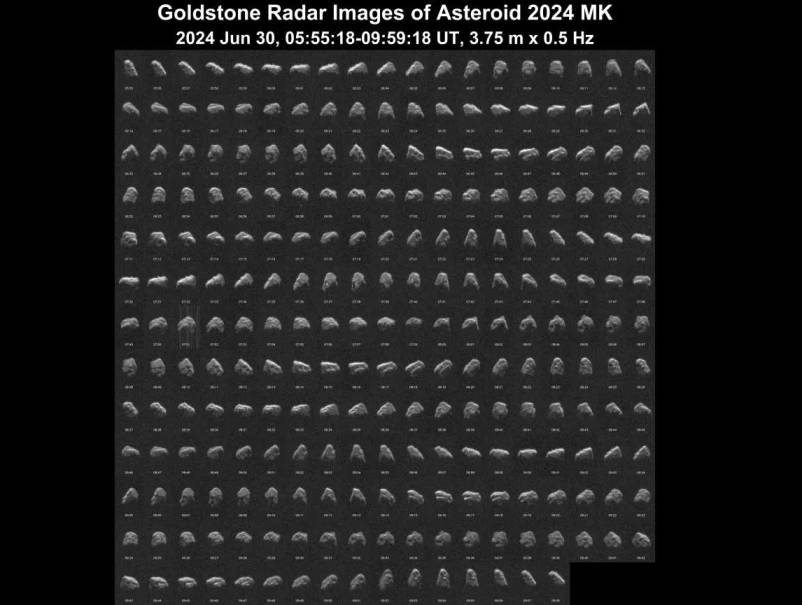
Because close encounters with asteroids the size of 2024 MK are relatively rare, JPL’s planetary radar array collected as much information as possible about the near-Earth object. This mosaic shows the asteroid rotating in one-minute increments about 16 hours after its closest approach to Earth. NASA/JPL-Caltech
Using the Deep Space Network’s 230-foot (70-meter) Goldstone Solar System Radar, called Deep Space Station 14 (DSS-14), near Barstow, California, JPL scientists transmitted radio waves to the asteroid and received the reflected signals with the same antenna. In addition to determining that the asteroid is roughly spherical, they found that it is a binary system: A smaller asteroid, or moon, orbits it at a distance of about 1.9 miles (3 kilometers).
“About two-thirds of asteroids this size are thought to be binary systems, and their discovery is particularly important because we can use measurements of their relative positions to estimate their mutual orbits, masses and densities, which provide key information about how they might have formed,” said Lance Benner, JPL’s principal scientist, who helped lead the observations.
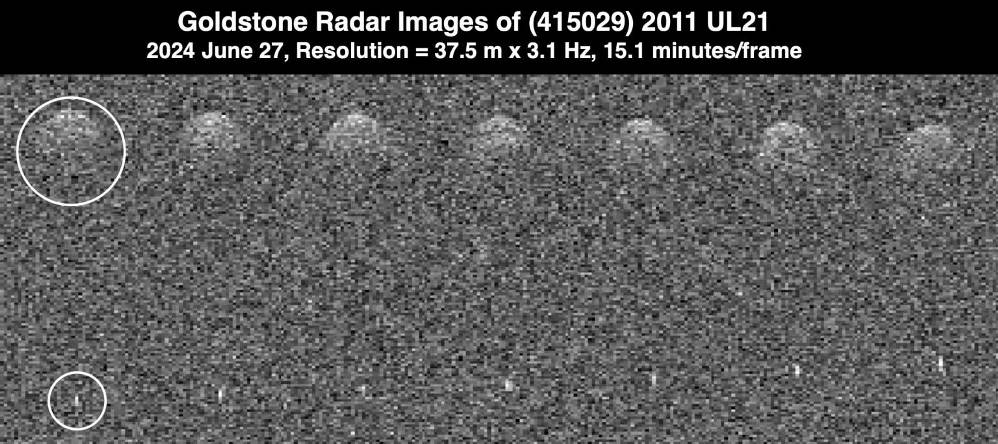
These seven radar observations from the Deep Space Network’s Goldstone Solar System Radar show the mile-wide asteroid 2011 UL21 during its close approach to Earth on June 27 at a distance of about 4 million miles. The asteroid and its small moon (the bright dot at the bottom of the image) are outlined in white. NASA/JPL-Caltech
Two days later, on June 29, the same team watched as asteroid 2024 MK flew past our planet from a distance of just 184,000 miles (295,000 kilometers), or just over three-quarters the distance between the Moon and Earth. The asteroid, about 500 feet (150 meters) wide, appears elongated and angular, with raised flat and rounded areas. For these observations, the scientists also used DSS-14 to transmit radio waves to the object, but they used Goldstone’s 114-foot (34-meter) DSS-13 antenna to receive the signal as it bounced off the asteroid and returned to Earth. The result of this “bistatic” radar observation is a detailed image of the asteroid’s surface, showing concavities, ridges, and boulders about 30 feet (10 meters) wide.
Close approaches of near-Earth objects the size of 2024 MK are relatively rare, occurring on average about every couple of decades, so the JPL team was eager to collect as much data on the object as possible. “This was an exceptional opportunity to study the physical properties and obtain detailed images of a near-Earth asteroid,” Benner said.
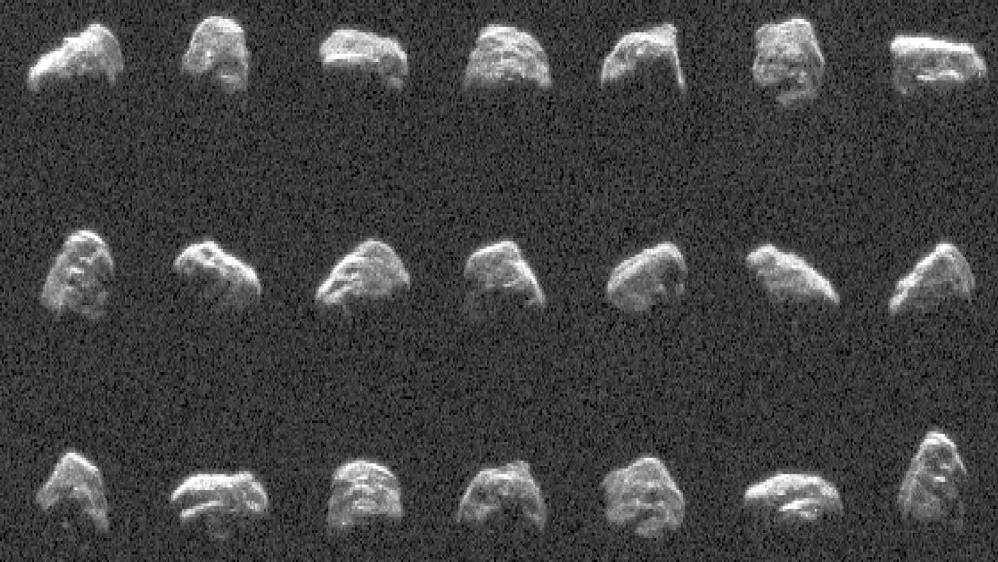
NASA’s Deep Space Network’s Goldstone Solar System Radar has observed the newly discovered 500-foot-wide (150-meter) asteroid 2024 MK, which made its closest approach to Earth — about 184,000 miles (295,000 kilometers) — on June 29. NASA/JPL-Caltech
Asteroid 2024 MK was first detected on June 16 by the NASA-funded Asteroid Terrestrial Alert System (ATLAS) at the Sutherland Observing Station in South Africa. Its orbit was altered by Earth’s gravity as it passed by, shortening its 3.3-year orbital period around the Sun by about 24 days. Although it is classified as a potentially hazardous asteroid, calculations of its future motion indicate that it does not pose a threat to our planet in the foreseeable future.
The Goldstone Solar System Radar Array is supported by NASA’s Near-Earth Object Observation Program in the Planetary Defense Coordination Office at the agency’s headquarters in Washington. Managed by JPL, the Deep Space Network receives programmatic oversight from the Space Communications and Navigation Program Office in the Space Operations Mission Directorate, also at NASA Headquarters.
The impact craters that scar the Earth’s surface are testament to the enormous impact asteroids have had on the history and development of our planet. The UN-endorsed Asteroid Day commemorates the largest recorded asteroid impact in history, the 1908 Tunguska blast in largely uninhabited Siberia that knocked down some 80 million trees.

Visualization of the synodic orbit of asteroid (415029) 2011 UL21
ESA is in a unique position as, with the cooperation and support of Member States, it can coordinate the data, information and expertise needed to understand and respond to the asteroid hazard in Europe, as well as contribute to humanity’s wider planetary defence efforts.
Over the past two decades, ESA has been detecting and analysing potentially hazardous near-Earth objects. It is estimated that there are around 5 million near-Earth objects larger than 20 m, the threshold above which a collision could cause damage to the Earth.
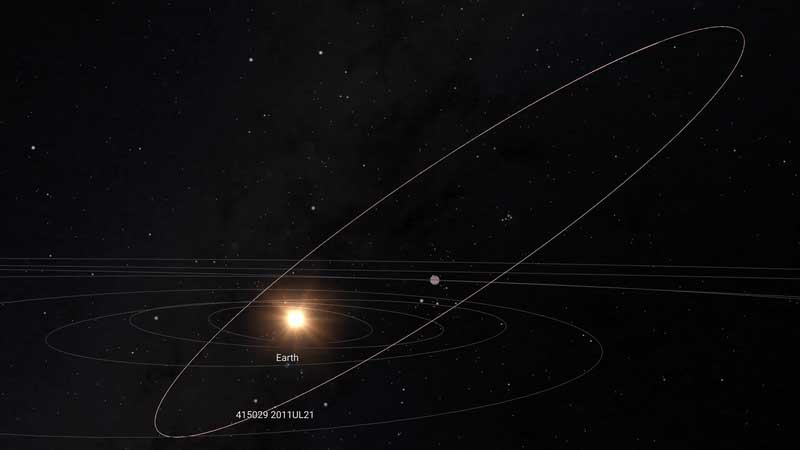
Asteroid (415029) 2011 UL21 flies past Earth
The launch of ESA’s Hera mission this year will be part of the world’s first asteroid deflection trial. Hera will conduct a detailed post-impact survey of the asteroid Dimorphos following the impact of NASA’s DART mission in September 2022, and will help develop the experiment into a well-understood and replicable planetary defence technique. On Earth, ESA is developing a network of insect-inspired Flyeye telescopes that will use their unique wide field of view to automatically scan the entire sky every night in search of new potentially hazardous asteroids.
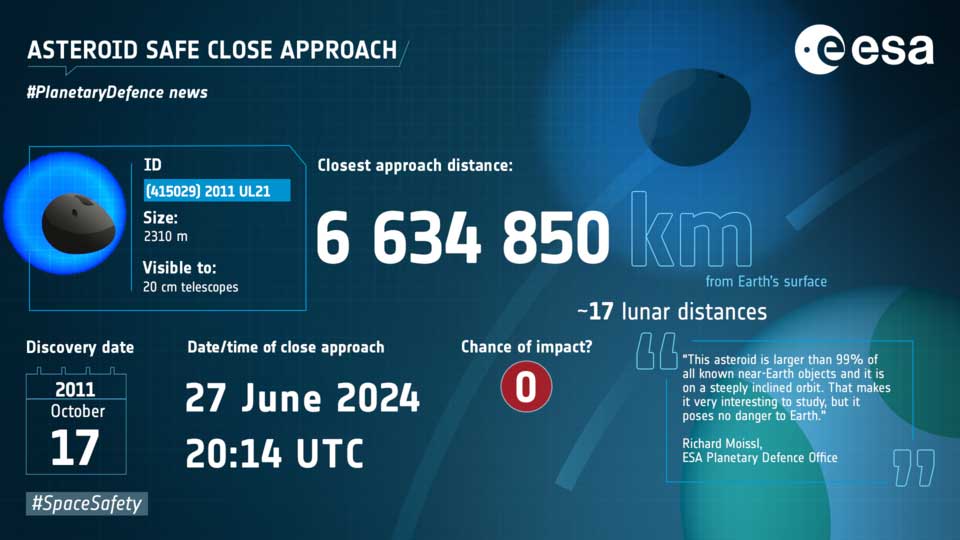
Close Approach of Asteroid (415029) 2011 UL21
The future NEOMIR satellite will be positioned between the Earth and the Sun. It will use infrared light to detect asteroids approaching our planet from areas of the sky that are not visible from Earth because they are obscured by the glare of our star.
Meanwhile, the Planetary Defence Directorate continues to keep a close eye on the skies today. ESA’s Fireball Camera in Cáceres, Spain, captured a stunning meteor on the night of 18-19 May 2024, believed to be a small fragment of a comet that passed over Spain and Portugal at around 162,000 km/h (102,000 mph) before burning up over the Atlantic Ocean.
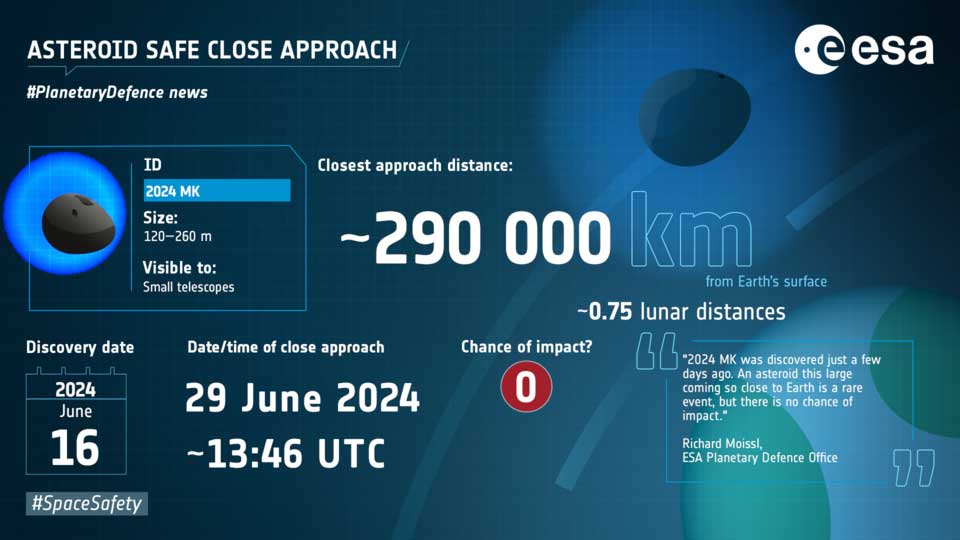
Close Approach of Asteroid 2024 MK
Just a couple of weeks later, on June 6, 2024, the Catalina Sky Survey in Arizona, USA, detected a small asteroid of 2-4 m in size, triggering an alert from ESA’s Meerkat Imminent Impact Monitoring System. This alert was not for an impact, but for a very close encounter. A few hours later, the object passed over the Catalina Sky Survey telescope, which detected it at a distance of just 1,750 km, making it the second-closest known asteroid ever to not collide with Earth.




